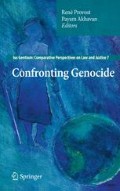Abstract
While the media has typically been viewed as an instrument of incitement in the perpetration of genocide, this article offers another perspective on the possibility of media as a tool to promote tolerance and contribute to peace-building efforts. The author concentrates her analysis on the use of “peace media” in sub-Saharan Africa and discusses the conflicting views of media’s purpose in that region of the world. The article promotes the idea that media/journalism can be appropriately and actively used for reconciliation purposes, not just to provide an “objective” view of news items.
Access this chapter
Tax calculation will be finalised at checkout
Purchases are for personal use only
Notes
- 1.
The role played by RTLM in the Rwandan Genocide and the concept of an ethics of communication are examined in Mark Thompson, Chapter 6 (above).
- 2.
See Mary Kimani, “RTLM : The Medium that Became a Tool for Mass Murder,” in The Media and the Rwanda Genocide, ed. Allan Thompson (London: Pluto Press, 2007), 110.
- 3.
For more on the cine-mobile program visit http://www.internews.fr/spip.php?article126.
- 4.
Alison Des Forges , Leave None to Tell the Story : Genocide in Rwanda (New York : Human Rights Watch , 1999).
- 5.
For a more detailed argument on this aspect of Rwandan history please refer to Fujii Lee Ann, “Origins of Power and Identity in Rwanda ,” paper presented at the Annual Conference of the International Studies Association, Chicago, IL, February 20–24, 2001.
- 6.
An account of the principal events of the Rwandan Genocide is provided in Douglas Greenberg, Chapter 5 (above).
- 7.
Reporters Without Borders, “Côte d’Ivoire – Annual Report 2005,” Reporters Without Borders, May 3, 2005, http://www.rsf.org/article.php3?id_article=13569 (Accessed June 9, 2009).
- 8.
The argument that rights of broadcasters are privileged over rights of the receiving public is put forward in Mark Thompson, Chapter 6 (above).
- 9.
See, for example, Kangura , Kangura Magazine, (UN ICTR evidence database) February 1992. One excerpt reads: “If there is no corresponding Hutu union in a quick response to the Tutsi union, it will soon be too late for any remedy . In their plans to seize power, Tutsis not only made provisions for armed conflict , they also thought of another form of fighting, which could be used in the event of the failure of armed conflict . It is on this strategy that the war today rests, since it has helped to prepare the war and will help to continue waging the war for as long as the Hutus have not been subjugated. Kangura will reveal this form, so that methods to free Hutus will be sought. For, they are now in the grip of the Tutsis, who are using this strategy. If nothing is done, they would die, as they should.”
- 10.
The impact of pejorative characterization of “out-groups” is analyzed in Yehuda Bauer, Chapter 7, Section 7.2 (above) and Irwin Cotler, Chapter 9, Section 9.4 (above).
- 11.
Andy Sennitt, “Replacing Hate with Hope in Kenya : Hate Radio Fans the Flames of Violence,” Radio Nederland Wereldomroep, January 31, 2008, http://www.radionetherlands.nl/features/080131-kenya-hate-radio (Accessed June 9, 2009).
- 12.
The formulation of media rights in terms of freedom of expression is examined in Mark Thompson, Chapter 6 (above).
- 13.
Prosecutor v. Ferdinand Nahimana, Jean-Bosco Barayagwiza and Hassan Ngeze, ICTR -99-52-T (ICTR December 3, 2003), http://69.94.11.53/default.htm (Accessed June 10, 2009).
- 14.
The characterization of genocidal events as acts of self-defense is discussed in Irwin Cotler, Chapter 9, Section 9.4.5 (above).
- 15.
Andy Sennitt, “Replacing Hate with Hope,” 2008.
- 16.
Andre Sibomana, Hope for Rwanda : Conversations with Laure Guilbert and Hervé Deguine (London: Pluto Press, 1999).
- 17.
Mary Kimani, “Broadcasting Peace: Radio a Tool for Recovery,” in Africa Renewal, October, 2007, 3.
- 18.
Linda Holguin and Adam Gordon , “The Media’s Role in Peace-building: Asset or Liability?,” The Media Research hub: Social Science Research Council, http://mediaresearchhub.ssrc.org/the-media-s-role-in-peace-building-asset-or-liability/resource_view (Accessed June 10, 2009).
- 19.
Ibid.
- 20.
See full story at http://www.dfid.gov.uk/Media-Room/Case-Studies/2007/Can-radio-help-end-conflict-peacefully-in-Uganda/ (Accessed June 15, 2009).
- 21.
Mary Kimani, “Broadcasting Peace,” 2007, 3.
- 22.
Yves Laplume, interviewed by author via telephone, July 27, 2007.
- 23.
Mary Kimani, “Broadcasting Peace,” 2007, 3.
Author information
Authors and Affiliations
Corresponding author
Editor information
Editors and Affiliations
Rights and permissions
Copyright information
© 2011 Springer Science+Business Media B.V.
About this chapter
Cite this chapter
Kimani, M. (2011). Creating the Essential Middle Ground: Using Media to Enhance Tolerance and Co-Habitation in Africa. In: Provost, R., Akhavan, P. (eds) Confronting Genocide. Ius Gentium: Comparative Perspectives on Law and Justice, vol 7. Springer, Dordrecht. https://doi.org/10.1007/978-90-481-9840-5_20
Download citation
DOI: https://doi.org/10.1007/978-90-481-9840-5_20
Published:
Publisher Name: Springer, Dordrecht
Print ISBN: 978-90-481-9839-9
Online ISBN: 978-90-481-9840-5
eBook Packages: Humanities, Social Sciences and LawPolitical Science and International Studies (R0)

